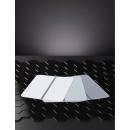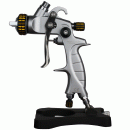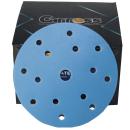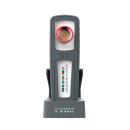Bodywork paint defects: causes and remedies
See the products concerned
Once the primer coat is completely dry, it's time to apply the paint. The original body paint for each vehicle is indicated by a colour code on the manufacturer's plate. Successful application depends on a number of factors: the quality and correct adjustment of the Spray gun, the painter's technical knowledge, compliance with the rules of use provided by the car paint manufacturer (different dilution rules for each manufacturer...)...).
Each of these parameters can therefore influence the quality of the final result. A wide range of bodywork paint defects can therefore occur:
Marbling / Metallic stains
Description
The presence of areas of different colours (lighter or darker), often arranged in stripes, in the metallic paint due to an abnormal arrangement of the aluminium particles.
Causes
- Inadequate application technique (Nozzle, pressure): uneven application of Matt basecoat, spraying too "heavy" or too dry, etc.
- Evaporation time too short.
- Use of an unsuitable Hardener.
- Substrate temperature too low or too high.
Preventive measures
- Follow a regular application technique, in accordance with the manufacturer's recommendations.
- Check that the spray gun is correctly adjusted.
- Thinner in accordance with the manufacturer's recommendations using the appropriate thinners.
- Ensure a suitable substrate temperature (ambient temperature between 18°C and 20°C) and a humidity level below 40 - 60%.
Remedies
Sand down to the primer, then reapply the base paint in accordance with the manufacturer's recommendations.
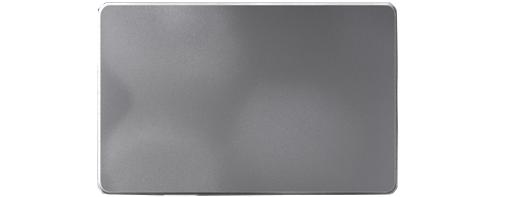
Colour matching problems
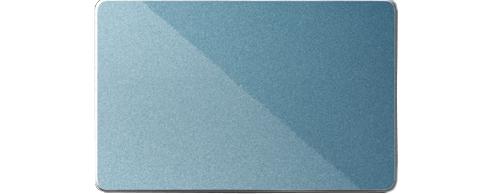
Description
Differences in colour tone: differences in colour tone particularly visible on adjacent panels.
Causes
- Incorrect choice of body paint colour.
- Insufficient mixing of the paint before use.
- Failure to comply with the prescribed application conditions (Nozzle, pressure, distance from the spray gun, number of coats).
- Inadequate spray technique: too wet, too dry, non-coating, etc.
Preventive measures
- Observe the application conditions specified on the product data sheet.
- Mix the colour carefully and filter it before application.
- Before painting the surface, always carry out a spray test on a separate surface and check that the tone matches from different angles and under different lighting conditions.
Remedies
Sand down to the primer, then reapply the base body paint after checking that the tone matches.
Craters/ Gaps
Description
Small circular cavities with raised edges on the surface of the paint film. In some cases, impurities can be seen in the centre of the crater. It should be noted that craters covered with body paint may, after the application of a repair paint that does not conform, become visible again in the form of flat cavities.
Causes
- Presence of wax, oil, grease and silicone impurities in the compressed air line.
- Inconsistent use of antistatic cloths with residues deposited on the backing, which subsequently cause craters to form.
- Use of polishing products containing silicones.
- For water-based products, presence of solvent in the gun.
Preventive measures
If possible, use silicone-free products in paint shops.
- Clean and degrease the surface very carefully before painting with an anti-silicone solvent.
- Regularly maintain the oil and water separators (filters) in the booth and the compressed air line.
- Clean and dry spray guns thoroughly after use.
Remedies
After the finish has dried completely :
- Sand down to the primer, clean thoroughly with an anti-silicone solvent, then repaint.
- In the event of highly visible problems, it may be necessary to use an additive to prevent cratering.
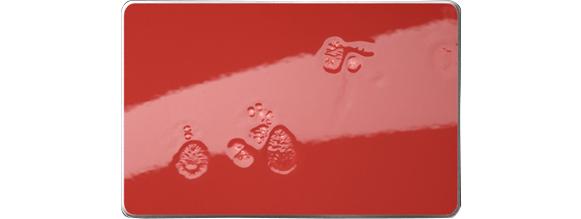
Water stains
Description
Presence of water spots on the surface of the finishing film. Small, light-coloured, whitish rings or blisters appear on the surface of the paint film as a result of the evaporation of water mixed with limescale and salt. The interior surfaces are generally sound, with slight prominences on the edges.
Causes
- Evaporation of drops of water that have fallen onto the film of paint (especially on horizontal surfaces) before it has finished drying.
- Insufficient drying of "fresh" paints
- Coats that are too thick are particularly sensitive.
- Incorrect dosage of Hardener.
Preventive measures
- Follow the application advice given on the manufacturer's data sheet.
- Protect the substrate immediately after painting to avoid contact with water.
- Respect the recommended drying time, as well as the recommended layer thicknesses and mixing proportions.
Remedies
After the finish has dried completely :
- Sand the affected area with fine paper and polish.
- In the case of very visible defects, it may be necessary to sand more thoroughly and then apply a new finish.
